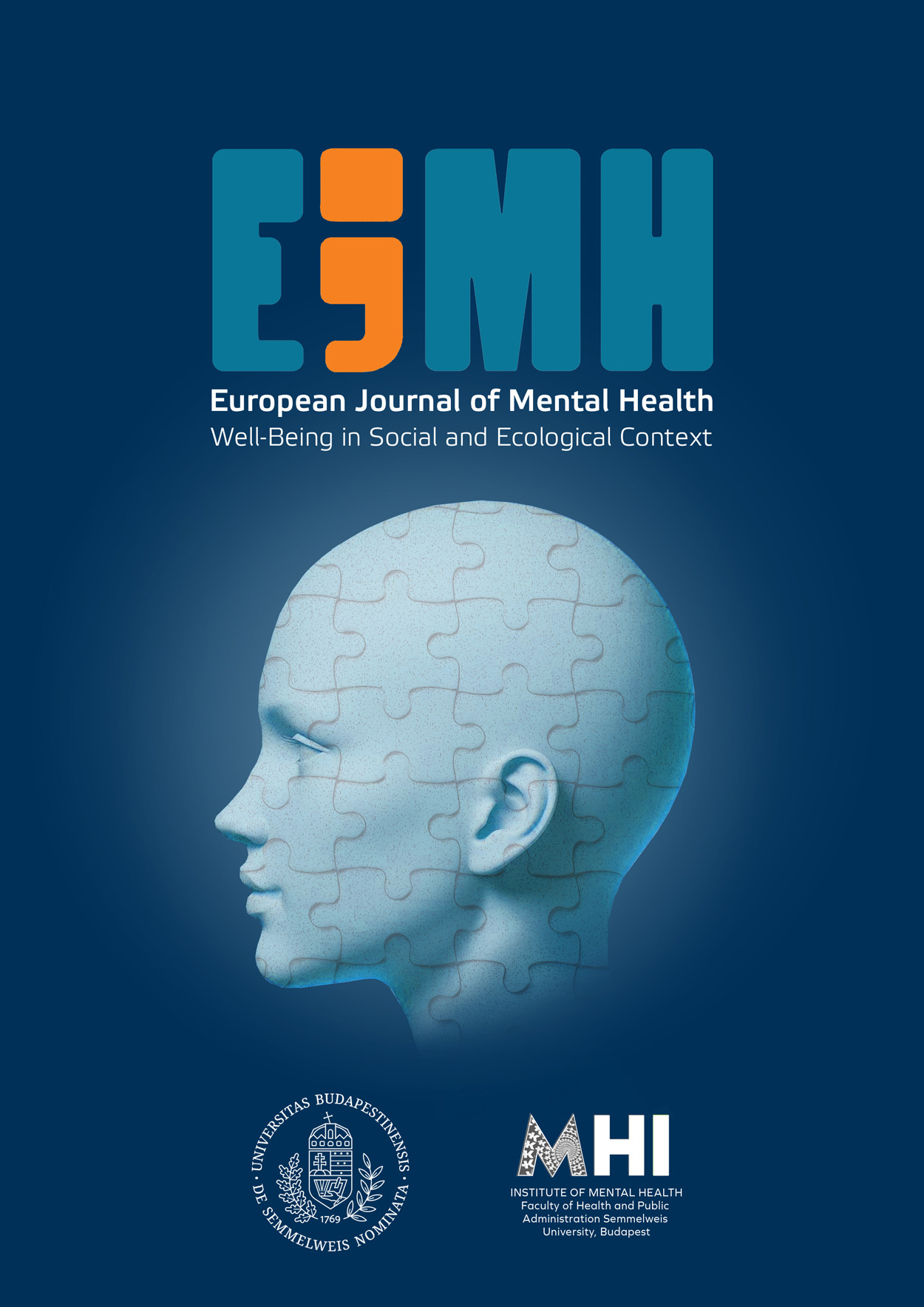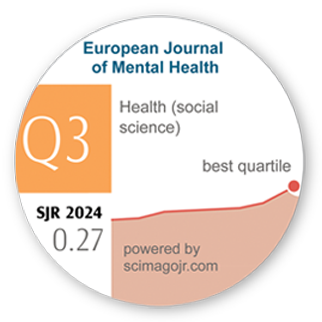The Impacts of Alexithymia and Sexual Distress on Sexual Functioning Among Portuguese Women
DOI:
https://doi.org/10.5708/EJMH.18.2023.0002Keywords:
sexual functioning, sexual distress, alexithymia, emotions, womenAbstract
Introduction: Recognizing own’s emotions seems to have an important role regarding not only our overall well-being, but also our sexual functioning.
Aims: The aim of this study is to analyze the association or impact of alexithymia on female sexual functioning.
Methods: 459 Portuguese women, with a mean age of 34.57 years (SD = 10.27), ranging from 18 to 65 years, completed the Toronto Alexithymia Scale (TAS-20), the Female Sexual Distress Scale – Revised (FSDS-R) and, additionally, completed the Female Sexual Function Index (FSFI), indicating if and when a sexual relationship occurred in the last month.
Results: The results showed that higher levels of alexithymia were associated with worse sexual functioning and higher levels of sexual distress. Higher levels of sexual distress were associated with worse sexual functioning. It was possible to establish a significant linear regression model between dimensions of alexithymia (difficulties in identifying feelings and difficulties in describing feelings) and sexual distress in sexual functioning; the variables together explained about 45.2% of sexual functioning in these women.
Conclusions: The results emphasize the relevance of alexithymia’s dimensions in sexual functioning concerning women with or without sexual dysfunction, since they present themselves as significant predictors. Professionals working in women's sexual health should take this into account for more effective assessment and intervention in matters concerning sexual health.
References
Akiyama, H., Antonucci, T., Takahashi, K., Langfahl, E. S. (2003). Negative interactions in close relationships across the lifespan. Journal of Gerontology. Series B, Psychological Sciences and Social Sciences, 58(2), 70–79.
https://doi.org/10.1093/geronb/58.2.P70
American Psychiatric Association (2000). Manual de Diagnóstico e Estatística das Perturbações Mentais [The Diagnostic and Statistical Manual of Mental Disorders] (4ªed). Climepsi Editores. Aydın, S., Onaran, Ö. I., Topalan, K., Aydın, Ç. A., & Dansuk, R. (2016). Development and Validation of Turkish Version of The Female Sexual Distress Scale-Revised. Sexual Medicine, 4(1), 43–50.
https://doi.org/10.1016/j.esxm.2015.12.003
Baumeister, R. F. (2000). Gender differences in erotic plasticity: The female sex drive as socially flexible and responsive. Psychological Bulletin, 126(3), 347–374.
https://doi.org/10.1037/0033-2909.126.3.347
Berengue, C., Rebôlo, C., Costa, R. M. (2019). Interoceptive awareness, alexithymia, and sexual function. Journal of Sex & Marital Therapy, 45(8), 729–738.
https://doi.org/10.1080/0092623x.2019.1610128
Birditt, K. S., & Fingerman, K. L. (2005). Do we get better at picking our battles? Age group differences in descriptions of behavioral reactions to interpersonal tensions. The Journals of Gerontology. Series B, Psychological Sciences and Social Sciences, 60(3), 121–128.
https://doi.org/10.1093/geronb/60.3.p121
Birnbaum, G. E., Reis, H. T., Mizrahi, M., Kanat-Maymon, Y., Sass, O., & Granovski- Milner, C. (2016). Intimately Connected: The Importance of Partner Responsiveness for Experiencing Sexual Desire. Journal of Personality and Social Psychology, 111(4), 530–546.
https://doi.org/10.1037/pspi0000069
Brewer, R., Cook, R., & Bird, G. (2016). Alexithymia: a general deficit of interoception. Royal Society Open Science, 3(10), Article 150664.
https://doi.org/10.1098/rsos.150664
Brody, S. (2003). Alexithymia is inversely associated with women’s frequency of vaginal intercourse. Archives of Sexual Behavior, 32(1), 73–77.
https://doi.org/10.1023/a:1021897530286
Ceunen, E., Vlaeyen, J. W. S., & Diest, I. V. (2016). On the origin of interoception. Frontiers in Psychology, 7, 1–17.
https://doi.org/10.3389/fpsyg.2016.00743
Chivers, M. L., & Bailey, J. M. (2005). A sex difference in features that elicit genital response. Biological Psychology, 70(2), 115–120.
https://doi.org/10.1016/j.biopsycho.2004.12.002
Costa, R. M., Pestana, J., Costa, D. & Coelho, M. P., Correia, C., & Gomes, S. (2018). Sexual desire, alexithymia, interoception, and heart rate variability. Journal of Sexual Medicine, 15(7), 175.
https://doi.org/10.1016/j.jsxm.2018.04.115
DeRogatis, L., Clayton, A. H., Lewis-D'Agostino, D., Wunderlich, G., & Fu, Y. (2008). Validation of the female sexual distress scale-revised for assessing distress in women with hypoactive sexual desire disorder. The Journal of Sexual Medicine, 5(2), 357–364.
https://doi.org/10.1111/j.1743-6109.2007.00672.x
DeRogatis, R. L., Clayton, A. H., Rosen, R. C., Sand, M., & Pyke, R. E. (2011). Should sexual desire and arousal disorders in women be merged? Archives of Sexual Behavior, 40(2), 217–219.
https://doi.org/10.1007/s10508-010-9677-1
Estrela, M., Herdeiro, M. T., Ferreira, P. L., & Roque, F. (2020). The Use of Antidepressants, Anxiolytics, Sedatives and Hypnotics in Europe: Focusing on Mental Health Care in Portugal and Prescribing in Older Patients. International Journal of Environmental Research and Public Health, 17(22), Article 8612.
https://doi.org/10.3390/ijerph17228612
Ferguson, J. M. (2001). The effects of antidepressants on sexual functioning in depressed patients: a review. The Journal of Clinical Psychiatry, 62(Supplement 3), 22–34.
https://pubmed.ncbi.nlm.nih.gov/11229450/
Füstös, J., Gramann, K., Herbert, B. M., & Pollatos, O. (2013). On the embodiment of emotion regulation: Interoceptive awareness facilitates reappraisal. Social Cognitive and Affective Neuroscience, 8(8), 911–917.
https://doi.org/10.1093/scan/nss089
Gitlin, M.J. (1997). Sexual side effects of psychotropic medications. In D. L. Dunner & J.F. Rosenbaum (Eds), Psychiatric Clinics of North America. Annual Drug Therapy, 4, 61–90. Gross J. J. (2015). The extended process model of emotion regulation: elaborations, applications, and future directions. Psychological Inquiry, 26(1), 130–137.
https://doi.org/10.1080/1047840X.2015.989751
Grynberg, D., & Pollatos O. (2015). Perceiving one's body shapes empathy. Physiology & Behavior, 140, 54–60.
https://doi.org/10.1016/j.physbeh.2014.12.026
Härtwig, E. A., Crayen, C., Heuser, I. & Eid, M. (2014). It's in the mix: psychological distress differs between combinations of alexithymic facets. Frontiers in Psychology, 5, Article 1259.
https://doi.org/10.3389/fpsyg.2014.01259
Herbert, B. M., & Pollatos, O. (2012) The body in the mind: on the relationship between interoception and embodiment. Topics in Cognitive Science, 4(4), 692–704.
https://doi.org/10.1111/j.1756-8765.2012.01189.x
Hill, M. M., & Hill, A. (2012). Investigação por Questionário [Doing Surveys using Questionnaires] (2a Ed.). Edições Sílabo. Jenczura, A., Czajkowska, M., Skrzypulec-Frankel, A., Skrzypulec-Plinta, V., & Drosdzol-Cop, A. (2018). Sexual function of postmenopausal women addicted to alcohol. International Journal of Environmental Research and Public Health, 15(8), Article 1639.
https://doi.org/10.3390/ijerph15081639
Kleinstäuber, M. (2017). Factors associated with sexual health and well-being in older adulthood. Current Opinion in Psychiatry, 30(5), 358–368.
https://doi.org/10.1097/yco.0000000000000354
Leising, D., Grande, T. & Faber, R. (2009). The Toronto Alexithymia Scale (TAS‐20): A measure of general psychological distress. Journal of Research in Personality, 43(4), 707–710.
https://doi.org/10.1016/j.jrp.2009.03.009
Leweke, F., Leichsenring, F., Kruse, J., & Hermes, S. (2011). Is alexithymia associated with specific mental disorders. Psychopathology, 45(1), 22–28.
http://dx.doi.org/10.1159/000325170
Liang, B. & West, J. (2011). Relational health, alexithymia, and psychological distress in college women: testing a mediator model. American Journal of Orthopsychiatry, 81(2), 246–254.
https://doi.org/10.1111/j.1939-0025.2011.01093.x
Madioni, F., & Mammana, L. A. (2001). Toronto alexithymia scale in outpatients with sexual disorders. Psychopathology, 34(2), 95–98.
https://doi.org/10.1159/000049287
Marôco, J. (2014). Análise Estatística com o SPSS Statistics [Statistical Analyses with the SPSS Statistics] (6a Ed). Edições Silabo. Mitchell, K. R., Mercer, C. H., Ploubidis, G. B., Jones, K. G., Datta, J., Field, N., Copas, A. J., Tanton,C., Erns, B., Sonnenberg, P., Clifton, S., Macdowall, W., Phelps, A., Johson, A. M., Wellings, K. (2013). Sexual function in Britain: findings from the third national survey of sexual attitudes and lifestyles (Natsal-3). The Lancet, 382(9907), 1817–1829.
https://doi.org/10.1016/s0140-6736(13)62366-1
Montoro, C. I., Reyes del Paso, G. A., & Duschek, S. (2016). Alexithymia in fibromyalgia syndrome. Personality and Individual Differences, 102, 170–179.
https://doi.org/10.1016/j.paid.2016.06.072
Nguyen, D. P., Klein, B., Meyer, D., Austin, D. W., & Abbott, J. A. (2015). The Diagnostic Validity and Reliability of an Internet-Based Clinical Assessment Program for Mental Disorders. Journal of Medical Internet Research, 17(9), e218.
https://doi.org/10.2196/jmir.4195
Avis, N. E. (2000). Sexual function and aging in men and women: community and population-based studies. Journal of Gender-Specific Medicine, 3(2), 37–41.
https://pubmed.ncbi.nlm.nih.gov/11253244/
Nobre, P. (2006). Disfunções Sexuais [Sexual Dysfunctions] (1ªEd). Climepsi Editores. Palser, E. R., Palmer, C. E., Galvez-Pol, A., Hannah, R., Fotopoulou, A., & Kilner, J.
M. (2018). Alexithymia mediates the relationship between interoceptive sensibility and anxiety. Plos One, 13(9), e0203212.
https://doi.org/10.1371/journal.pone.0203212
Pechorro, P., Diniz, A., Almeida, S., & Vieira, R. (2009). Validação portuguesa doíndice de Funcionamento Sexual Feminino (FSFI) [Portuguese validation of the Female Sexual Functioning Index (FSFI)]. Laboratório de Psicologia, 7(1), 33–44.
http://dx.doi.org/10.14417/lp.684
Prazeres, N., Parker, D. A., & Taylor, G. J. (2000). Adaptação Portuguesa da Escala de Alexitimia de Toronto de 20 Itens (TAS-20) [Portuguese adaptation of the 20-item Toronto Alexithymia Scale (TAS-20)]. Revista Iberoamericana de Diagnóstico y Evaluación Psicologica, 9(1), 9–21.
https://www.researchgate.net/publication/285820780
Price, C. J., & Hooven, C. (2018). Interoceptive awareness skills for emotion regulation: theory and approach of mindful awareness in body-oriented therapy (MABT). Frontiers in Psychology, 9, 798.
https://doi.org/10.3389/fpsyg.2018.00798
Ribeiro, B, Magalhães, A. T., & Mota, I. (2013) Disfunção sexual feminina em idade reprodutiva – prevalência e fatores associados [Sexual dysfunction in reproductive age – prevalence and associated factors]. Revista Portuguesa De Medicina Geral E Familiar, 29(1), 16–24.
https://doi.org/10.32385/rpmgf.v29i1.11044
Rosen, R., Brown, C., Heiman, J., Leiblum, S., Meston, C., Shabsigh, R., Ferguson, D., & D'Agostino, R. (2000) The Female Sexual Function Index (FSFI): A multidimensional self-report instrument for the assessment of female sexual function. Journal of Sex & Marital Therapy, 26(2), 191–208.
https://doi.org/10.1080/009262300278597
Scimeca, G., Bruno, A., Pandolfo, G., Micò, U., Romeo, V. M., Abenavoli, E., Scimmenti, A., Zoccali, R., & Muscatello, M. R. A. (2013). Alexithymia, negative emotions, and sexual behavior in heterosexual university students from Italy. Archives of Sexual Behavior, 42(1), 117–127.
https://doi.org/10.1007/s10508-012-0006-8
Sifneos, P. E. (1973). The prevalence of “alexithymic” characteristics in psychosomatic patients. Psychotherapy and Psychosomatics, 22(2), 255–262.
https://doi.org/10.1159/000286529
Sowden, S., Brewer, R., Catmur, C., & Bird, G. (2016). The specificity of the link between alexithymia, interoception, and imitation. Journal of Experimental Psychology. Human Perception and Performance, 42(11), 1687–1692.
https://doi.org/10.1037/xhp0000310
Taylor, G. J., Bargby, R. M., & Parker, J. D. A. (2016). What’s in the name ‘alexithymia’? A commentary on “Affective agnosia: expansion of the alexithymia construct and a new opportunity to integrate and extend Freud’s legacy.” Neuroscience and Biobehavioral Reviews, 68, 1006–1020.
https://doi.org/10.1016/j.neubiorev.2016.05.025
Taylor, G. J., Bagby, R. M., & Parker, J. D. A. (1997). Disorders of Affect Regulation: Alexithymia in Medical and Psychiatric Illness. Cambridge University Press. Trevisan, D. A., Altschuler, M. R., Bagdasarov, A., Carlos, C., Duan, S., Hamo, E., Kala, S., McNair, M. L., Parker, T., Stahl, D., Winkelman, T., Zhou, M., & McPartland, J. C. (2019). A meta-analysis on the relationship between interoceptive awareness and alexithymia: distinguishing interoceptive accuracy and sensibility. Journal of Abnormal Psychology, 128(8), 765–776.
http://dx.doi.org/10.1037/abn0000454
Wiegel, M., Meston, C., & Rosen, R. (2005). The Female Sexual Function Index (FSFI): cross-validation and development of clinical cutoff cores. Journal of Sex & Marital Therapy, 31(1), 1–20.
https://doi.org/10.1080/00926230590475206
Wiens, S., Mezzacappa, E. S., & Katkin, E. S. (2000). Heartbeat detection and the Experience of emotions. Cognition and Emotion, 14(3), 417–427.
https://doi.org/10.1080/026999300378905
Wise, T. N., Osborne, C., Strand, J., Fagan, P. J., & Schmidt, C. W. (2002). Alexithymia in patients attending a sexual disorders clinic. Journal of Sex and Marital Therapy, 28(5), 445–450.
https://doi.org/10.1080/00926230290001556
Witting, K., Santtila, P., Varjonen, M., Jern, P., Johansson, A., von der Pahlen, B., & Sandnabba, K. (2008). Female sexual dysfunction, sexual distress, and compatability with partner. Journal of Sexual Medicine, 5(11), 2587–2599.
https://doi.org/10.1111/j.1743-6109.2008.00984.x






